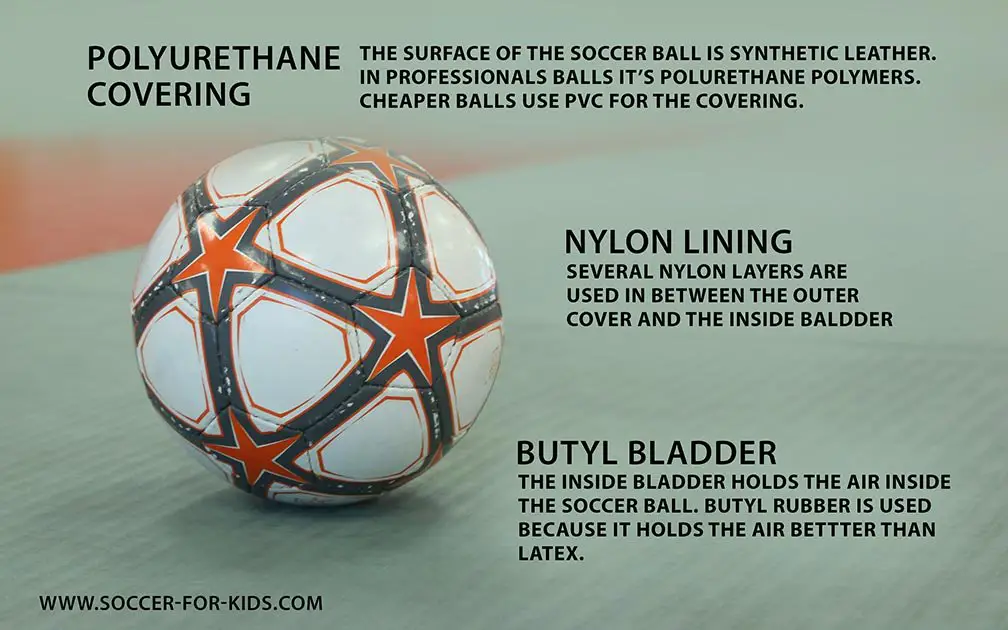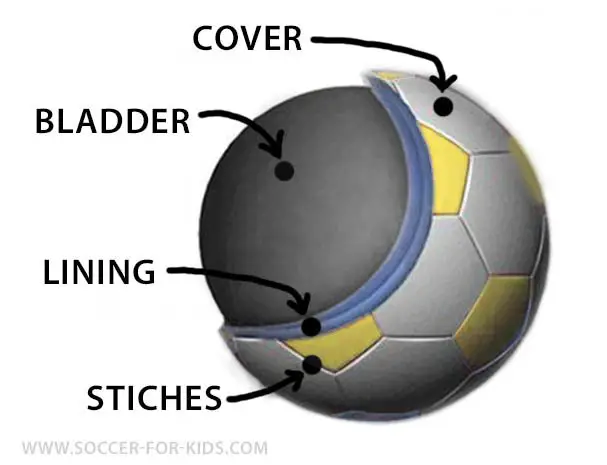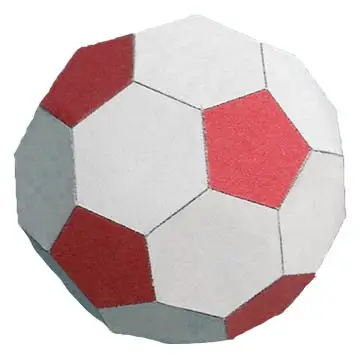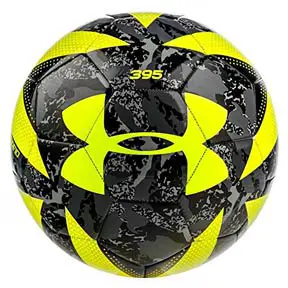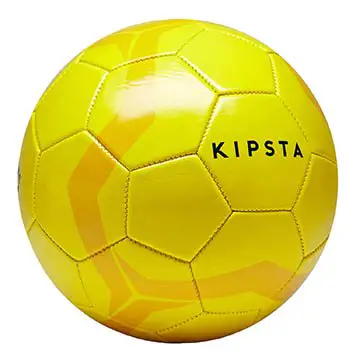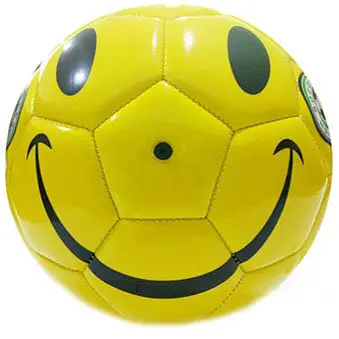what's a soccer ball made of
It's a frequently asked question. You're curious about what a soccer ball is made of. Soccer balls can be made from a variety of materials, depending on the quality and the specific venue the ball will be played with. Generally soccer balls are made up of 3 basic materials, plus the stitching and the valve.
Whether it's a soccer ball for kids or an adult soccer ball, the construction materials and design are the same.
what's inside a cut open soccer ball
The very inside material, the bladder, holds the air and is designed to maintain the proper soccer balls air pressure. Surrounding the bladder is usually one or more liners and the outside cover is made up of a durable cover made to handle the outdoor environment and frequent kicking.
If you want to see the inside of a soccer ball watch this video from HobbyKidsTV that shows you the cutting of a soccer ball. Kids, don't try this without help from a grown up. The saw and the tin snips used to cut open this soccer ball have sharp edges.
What is the best material for a soccer ball?
As mentioned above, there are several materials that can be used for each component of the modern soccer ball. The materials used have a big impact on how the soccer ball behaves as well as how much it will cost. Let's take a look at the different components that go into your soccer ball.
The bladder
NATURAL LATEX. The feel the softest, but but slowly leak air due to the tiny little pores that let some air escape over time. These are used in professional level soccer matches.
CARBON LATEX. Thy eleak much slower because tiny little particles of carbon lug up the little pores and prevent as much air from escaping.
BUTYL. Butyl is used in most of the mid to upper quality soccer balls. Soccer balls made with butyl bladders will keep sufficient air in them to be used for several weeks without pumping them back up.
The lining
There is a lot of variation in the materials used in the liner between the bladder and the outside cover of soccer balls. Some balls have several layers and really cheap balls can have only a single liner. A foam liner is often used in the manufacturing of soccer balls to add a cushioning effect as well as to give the soccer player more control of the ball.
Cheap balls with 1 or 2 layers in the liner are often tougher to control and not as pleasant to kick. Balls for professional soccer players offer several layers in theri liners are are delightful to play soccer with.
Soccer Ball panels
 Star Shaped Ball Panel
Star Shaped Ball Panel Hexagonal Ball Panel
Hexagonal Ball Panel Double Oval Ball Panel
Double Oval Ball PanelFor many years the standard Buckminster, known as the "Buckyball" style of 32 polygonal-shaped panel soccer ball was used exclusively. Then 26 and 18 panel soccer balls became the hot topic of soccer ball construction.
Often less panels on a soccer ball means fewer seams, which translate to a rounder shape and less water uptake.
Nowadays, there are even more options available as to the number and shape of panels that make up a soccer ball. Previously, the panels were sticked together. Now they can be glued or thermally bound together. This opens the door for an infinite number of unique soccer ball designs.
The air valves

SILICONE. Silicone is used in the highest quality balls. This material makes it easier to insert the ball needles into the ball for adding air.
BUTYL. These are used in the most soccer balls and keep the air inside the bladder very efficiently. Butyl is very elastic and closes quickly when you remove the needle.
soccer craft for kids: How to make a paper soccer ball
Need an indoor activity for a rainy day? Here's a soccer craft that will last a real long time. Why not have your young soccer player (not too young) construct their own soccer ball out of paper? The list of materials is quite simple:
- Construction paper. Use different colors for the pentagons and the hexagons for the best look.
- Scissors. Use supervision for children.
- Glue stick. Provides the easiest way to attach the panels to each other.
- Templates for both pentagon and hexagon shapes. Here is the free paper soccer ball template.
Here's a video from Youtube to help you see how to make a soccer ball out of paper.
TIPS FOR MAKING A soccer ball out of paper
- Soccer balls made out of paper and a glue stick will not stand up to vigorous kicking. Think of your paper soccer ball as a display of artwork, not a play toy.
- You can add some stability by filling with crinkled up paper inside.
- Real paper glue would be harder to work with, but may give a more permanent adhesion.
- You may find it easier to glue the panels together if you cut the foldable tabs a little bigger than the template shows.
Note: these soccer balls were the most popular soccer ball design in the total history of soccer. They have 32 panels: 12 of the pentagon panels, and 20 of the hexagonal panels.
As an Amazon associate, soccer-for-kids receives a small commission for qualifying purchases. There is no cost to you. Zero!
soccer match balls vs soccer training PRACTICE balls
soccer balls for training
Recreational youth soccer programs use training balls for their matches. They don't need the cost or the quality of match balls to play their games. Soccer balls for training are of medium quality. They are designed to be extra durable with the constructions materials used and hold up to thousands of kicks and touches over several years of practice.
Training balls are perfect for practicing your juggling in the backyard or kicking around at the school yard. They cost less and should last longer than a match ball.
soccer balls for matches
With youth soccer, most leagues do not require a special ball for matches. They do need to be of good quality, but it would be an unnecessary expense to use the same quality ball as is used in professional matches.
The balls that are used for higher level soccer matches are made of the highest quality materials. Players want the ultimate in performance and feel, so they are made to satisfy the players. Match balls use a thicker layer of foam under the cover to facilitate the best control for passing and shooting.
Players want to use a ball that they can "bend it like Beckham" and dip, or curve as it travels through the air.
Keep it positive. Keep it fun!

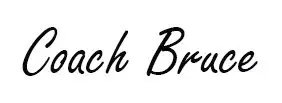
Soccer coach Bruce Lovelace started playing soccer in 1974 when, as a young boy, he constructed his own makeshift soccer goal. He played in high school, then in college and beyond. He started to coach his own children in the 1990s and then ran a Soccer Shots franchise for 12 years. Now, Coach Bruce publishes the soccer-for-kids.com website. Find out more about youth soccer coach Bruce Lovelace and what inspires this website.
Soccer-for-kids.com is a participant in the Amazon Services LLC Associates Program, an affiliate advertising program designed to provide a means for sites to earn advertising fees by advertising and linking to Amazon.com
